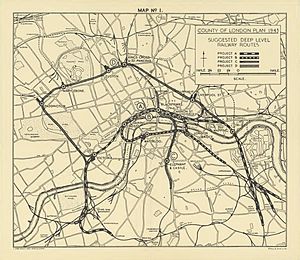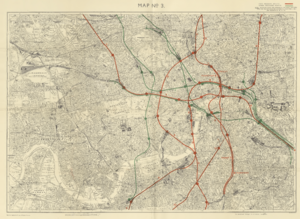County of London Plan facts for kids
 |
|
| Author | Patrick Abercrombie and J.H. Forshaw |
|---|---|
| Country | United Kingdom |
| Language | English |
| Subject | Urban planning |
| Publisher | Macmillan and Company Ltd |
|
Publication date
|
1943 |
| Media type | Print (Hardback) |
| Pages | 188 |
The County of London Plan was a big idea for how to rebuild and improve London after World War II. It was created in 1943 by two experts, John Henry Forshaw and Sir Leslie Patrick Abercrombie.
London had changed a lot over the years and grown in a messy way. The plan was made before the war ended, to get ready for fixing the city after it was damaged by bombs. It also aimed to help with the large number of people moving around.
The plan looked at five main problems in London and suggested ways to fix them:
- Traffic jams: Too many cars and not enough good roads.
- Bad housing: Many homes were old, crowded, or damaged.
- Not enough green spaces: There weren't enough parks or open areas, or they were in the wrong places.
- Mixed-up areas: Homes and factories were often built right next to each other.
- City sprawl: London was growing too much, spreading out into the countryside.
Contents
Planning Better Roads in London
One of the big ideas in the plan was to build special roads called ring roads around London. These roads would help traffic move more easily around the city, instead of going straight through the busy centre.
The "C Ring" Road
The plan suggested building several ring roads. One of them, called the "C Ring," was meant to include what is now the South Circular Road. Even though the full, high-quality road wasn't built, the idea led to using existing roads in a semi-circle around the southern parts of London. Building these roads would have caused a lot of changes, even in areas damaged by bombs. A similar idea for ring roads was brought up again in the 1960s, known as the London Ringways.
Earlier Road Ideas
Before the County of London Plan, other people had ideas for improving London's roads.
- In 1905, a group called the Royal Commission on London Traffic suggested a "circular road" about 75 miles long.
- In 1937, the Ministry of Transport published a survey. It suggested building many new roads and improving busy intersections. It also proposed a series of orbital roads, with the outer ones designed like American-style parkways. These are wide, green roads with limited entry points and special crossings that go over or under other roads.
Improving Train Services
The plan also had big ideas for London's train system. It suggested making all train lines electric. It also wanted to remove train tracks that were built high up on bridges or viaducts. Getting rid of train bridges over the River Thames was a key goal. This would allow the South Bank area to be redeveloped and used for other things.
New Underground Tunnels
A very ambitious part of the plan was to build a system of deep, two-track tunnels under the city. These tunnels would be big enough for regular mainline trains, not just tube trains. This meant people could travel long distances without having to switch from a mainline train to a tube train. Some existing tube lines, like the northern part of the Circle line, might even be used only for carrying goods.
The plan suggested several new underground train tunnels:
- A loop along the north side of the Thames, connecting places like Battersea, Victoria, Charing Cross, and Deptford. This would remove the need for high-up tracks at many stations.
- A loop to get rid of train bridges over the Thames, connecting Charing Cross, Cannon Street, Waterloo Junction, and London Bridge.
- A North-South Tunnel from Herne Hill in the south to King's Cross in the north.
- A Northern Arc connecting major stations like Paddington, Marylebone, Euston, King's Cross, and Liverpool Street.
Freight Train Rings
The plan also proposed two rings of railways just for carrying goods:
- An Inner Goods Ring: The northern part of the Inner Circle (now the Circle line) would be used for freight. It would then connect to the southern parts of London to form a full circle.
- An Outer Goods Ring: This would be an arc across northern London, running mostly north of Euston Road. It's not clear if this would be above ground or in a tunnel, but a tunnel under the Thames at Greenwich was mentioned.
What Happened to the Train Plans?
In 1946, a committee looked at these train proposals. They decided that the ideas were too expensive and would take too long to build. They thought it would cost about £230 million and take at least 30 years! Because of this, most of the big tunnel plans were not built. However, the North-South Tunnel idea was supported by the committee.
See also
- Greater London Plan
- Park system
- Landscape planning
- North Circular Road - the road that goes around north London, like the South Circular Road.
- M25 London Orbital Motorway - the biggest ring road around London, finished in 1986.
Images for kids





